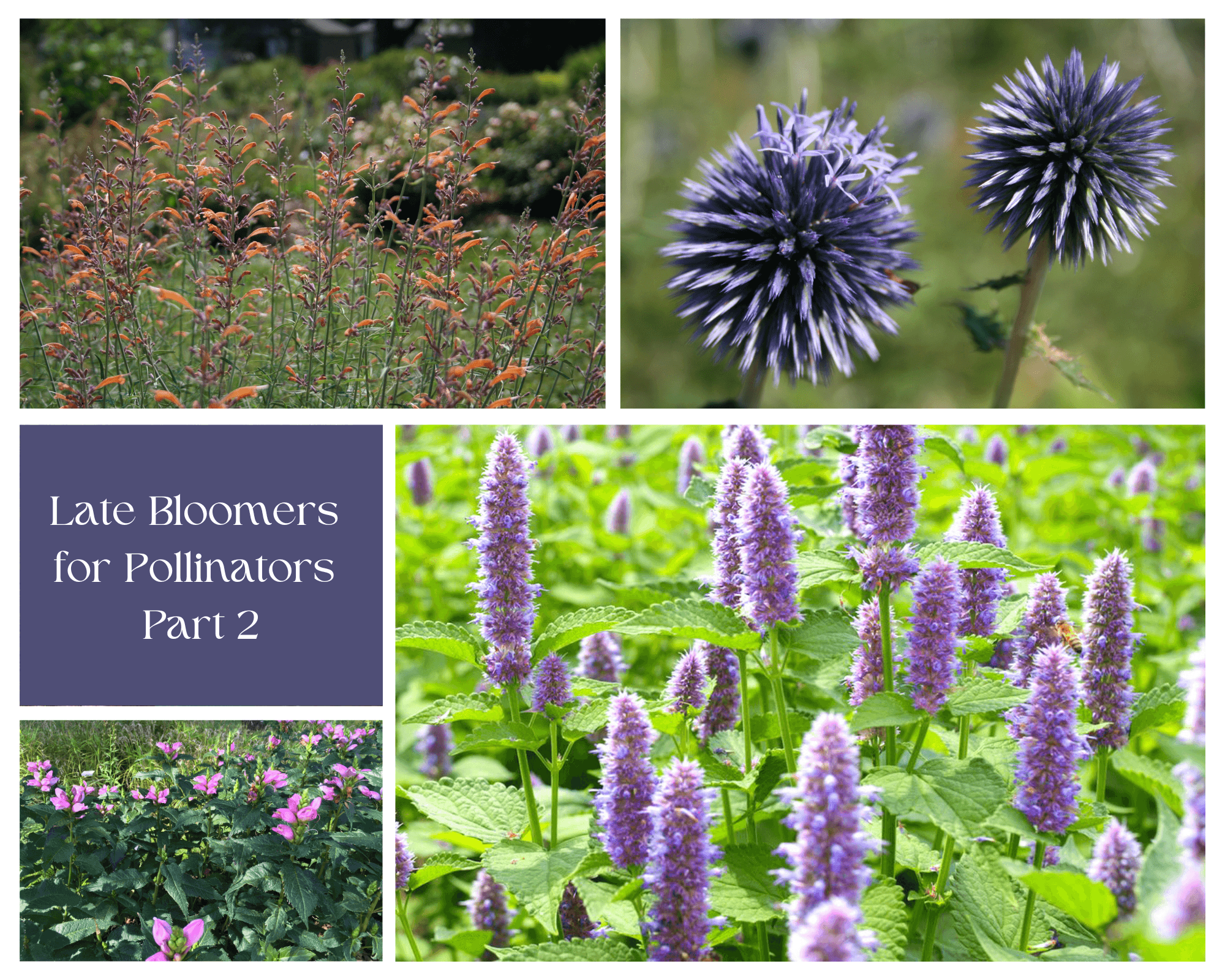
Images clockwise from top left: licorice mint hyssop (Agastache rupestris), blue globe thistle (Echinops ritro), blue giant hyssop (Agastache foeniculum) and turtlehead (Chelone lyonii)
Having flowers that provide pollen and nectar for pollinating insects is important throughout the growing season, but in late summer and early fall they can be especially crucial. As summer fades, bees are busy building their energy reserves in order to survive the winter and get off to a good start in spring. Adding a few of these late bloomers to your yard can help bees and other pollinators that are making a last dash for sustenance at the end of the season.
In honor of the Autumn Equinox (first official day of fall), here are four more late bloomer pollinator plants to consider for your yard or garden (read part one of our late bloomer pollinator series).
Blue Giant Hyssop (Agastache foeniculum)
A member of the Lamiaceae (mint) family, Agastache foeniculum grows to 2-4 feet, with dense, terminal spikes of bright blue-purple flowers. It sometimes goes by the name anise hyssop, as its leaves, when crushed or rubbed, emit a licorice or anise scent. The genus Agastache describes the flower clusters and is derived from two Greek words: "agan," meaning much and "stachys," meaning ear of grain.
Blue giant hyssop is versatile in that it thrives in sun, part shade or full shade. It also prefers moist, well-drained or sandy soils and is drought-tolerant. According to the Xerces Society, blue giant hyssop is especially valuable to bumble bees and honey bees.
Licorice Mint Hyssop (Agastache rupestris)
Another member of the Lamiaceae family, Agastache rupestris—commonly known as giant hyssop, threadleaf giant hyssop, licorice mint hyssop (because of the scent of its leaves) or sunset hyssop (because of its orangey-purple flowers)—is a clump-forming perennial that typically grows to 2-3 feet tall. Small, tubular, two-lipped, orange flowers with purplish calyxes bloom from July through September, with narrow, aromatic (anise scented), thread-like gray-green leaves. Sometimes the plant will rebloom later in the fall if it has been cut back in late summer after the initial flowering period.
Licorice mint hyssop is easily grown in average, dry to medium moisture, well-drained soils in full sun to part shade. It does best with medium moisture, particularly during the first year, but it will do poorly and may not survive winter in hard clay soils that retain moisture. Once established, licorice mint hyssop will tolerate heat and drought. It’s also very attractive to hummingbirds and butterflies.
Blue Globe Thistle (Echinops ritro)
Echinops ritro blooms unique, globular, thistle-like, deep blue flower heads from July through September. It grows to about 4 feet high, with spiny, gray-green leaves. Its scientific name comes from the Greek words “echinos,” meaning a hedgehog and “ops,” meaning appearance in reference to the flower heads.
Blue globe thistle thrives in average, dry to medium, well-drained soils in full sun, but it will tolerate poor, dry soil as well. It does not like rich, fertile soil. You should decide in advance where you want this particular plant in your yard because its long taproot makes it difficult to divide or transplant. Echinops ritro attracts many pollinators but is particularly appealing to bumble bees, which are drawn to the blue-purple hue of the blooms.
Turtlehead (Chelone lyonii)
Chelone blooms in late summer into the fall with clusters of snapdragon-like flowers that some say resemble the head of a turtle (thus its common name). Individual florets are tubular with two lips, with the upper portion serving as a protective hood and the lower lip as a stable place for pollinators to land. It’s not uncommon to see a bee burrow its body almost entirely into the bloom. The genus name comes from Chelone (which means tortoise in ancient Greek), a nymph in Greek mythology who was turned into a turtle as punishment for refusing to attend Zeus and Hera’s wedding.
Turtlehead grows 2-3 feet tall and thrives in sunny, moist or boggy sites; moist, partly shaded woodlands or in gardens that get frequent irrigation. This plant would do well in a rain garden, but it can tolerate drought conditions once it’s established.


